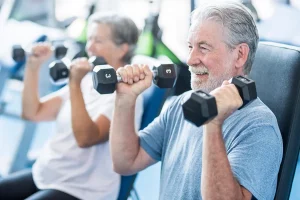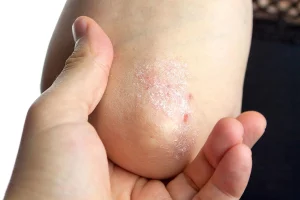I DON’T THINK I started having the self-perception and body image issues that have been plaguing me most of my life until the eighth grade, when one of my male classmates made an offhanded remark about my “big titties.” The way he said it, nonchalantly but with definite disdain, as if it was the most obvious thing in the world to everybody, me included, is what I remember most clearly about this moment. I’m not blaming him for the poor relationship I’ve had with food and my body in the years since – I’m pretty sure that the seeds were already planted in a fertile bed of low self-esteem, just waiting for the right moment to sprout. It’s the first time, though, that I realized that there were standards for the way a male body should look, that mine wasn’t meeting them, and that not meeting them was not an option if I wanted to fit in.
I had always been chubby as a kid, my baby fat never melting off, but rather congealing into pre-adolescent, and then adolescent, fat. And I had never really cared, at least not more than in passing. After that incident, though, I couldn’t stop looking at my chest. Why was it different from the chests of other boys in class? How could I make mine look like theirs? This critical gaze would then inevitably shift to other parts of my body: my stomach, my arms, my ass, all of them bulging in the same way my chest did. It didn’t help that I was also coming to terms with my sexuality, realizing that I was attracted to the male body, bodies that definitely didn’t look like mine but which I desired — in more ways than one.
When I started going through puberty a few months later, I thought the answers to my prayers had come. Everyone, from family members to textbooks, said that puberty would change my body for the better, and it did; my body stretched and grew, spreading the deposits of fat across my frame in a more egalitarian manner. But when the initial growth spurt subsided, I was left feeling like it wasn’t enough, like the process that should have transformed my body into the kind that I admired in my peers and crushes was unfairly cut short. So I joined the track team, hoping I could burn the fat off by running it into nonexistence. And that worked for a while, too, until the results reached a plateau, until my body refused to behave the way I thought it should. And it still wasn’t enough. I had already reached the point where there could never really be an “enough.”
My senior year of high school is when I turned to what I thought, at the time, was the source of my problem: food. I rationalized that if I couldn’t control the way my body processed (or refused to process) those stubborn little bulges that just refused to disappear, I could at least control whether or not it made new ones. I slowly started to wean myself off the normal amount of food I was used to consuming, timing my routine in the morning so that I would be too rushed to eat breakfast, giving away or even tossing my lunches entirely. The only time I couldn’t get away with not eating was at dinner, which I would have with my mom and sister. Even then, if I was lucky, I would be able to claim something along the lines of a stomachache or headache, and with a bit of acting and shameless appeals to a mother’s sympathy and worry, I could get away with not finishing the food on my plate. Finally! Here were the results that I wanted, here was my body finally behaving the way I had wanted it to for so long. It felt good, even through the fatigue and dizziness and mental haze and constant worrying about how I would navigate the next time I came face-to-face with food and was expected to eat it. It felt like I was in control, when, in fact, I was spiraling out of it.
**
People mostly use the word “spiral” when talking about depression, alluding to the sense of being in a constant downward descent that so many people who experience depression describe. I think “spiral” should be used to describe the reality of struggling with an eating disorder, too; how else could you explain how I went from worrying about my weight, to trying to get rid of it by exercise, to trying to prevent myself from gaining it by eating less, to finally trying to purge myself of whatever meager calories I would consume by throwing them up? I had only been in college for a few months when I started ending every meal with a trip to the bathroom, where I would promptly force myself to vomit whatever I had just eaten.
At the time, it felt like a rational extension of my decision to control what my body would consume and how it would do it. The friends I was making either didn’t notice my disappearing act or weren’t comfortable talking about it with someone they were still getting to know. It was the ideal situation for someone with my mentality. It wasn’t until the night that one of my oldest childhood friends overheard me throwing up in the bathroom after dinner, a friend who knew me intimately and had no qualms about confronting me, that I began to entertain the idea that I actually had a problem, that maybe I had an eating disorder.
I’m sharing this story because this week marks National Eating Disorders Awareness Week, an attempt by the National Eating Disorders Association to bring the reality and seriousness of eating disorders into the public’s consciousness. Some researchers estimate that, in the US alone, “20 million women and 10 million men suffer from a clinically significant eating disorder at some time in their life, including anorexia nervosa, bulimia nervosa, binge eating disorder, or an eating disorder not otherwise specified.” And while many people continue to describe and envision eating disorders as a women’s problem (which, while overly reductive, is understandable, since women, especially Western ones, are being bombarded by destructive body images and tropes on a second-by-second basis), the truth is, eating disorders to do not discriminate based on gender. Anyone, man or woman, who begins to feel that his or her body is inadequate, is at risk of developing an eating disorder. With all the pressure both genders feel to conform to certain aesthetic ideals, and mixed messages about food and nutrition constantly coming at us from right and left, “normal” dieting can easily turn into pathological dieting, which in turn can become full-blown eating disorders. Because the signs are easy to miss and because eating disorders, weight, and body image are still very taboo subjects, people around you could be struggling, in silence, without you ever being aware of it.
Eating disorders aren’t anything to be taken lightly, even though it seems that, unless a celebrity or other famous individual is dealing with allegations of having one, eating disorders aren’t discussed, or are treated flippantly when they are. But the fact remains that people die every day from the complications that anorexia nervosa, bulimia nervosa, and other eating disorders cause to their health. It’s important to seek some kind of treatment to help reshape the relationships between the person suffering and food, body image, and the body in general. Being confronted about my own issues by my friend startled me enough that I was able to examine my actions and, more importantly, my thoughts, and I eventually started seeing a therapist at my university on a regular basis. And it helped. A lot. I won’t go as far as to say that I’m “cured,” because I think issues like positive body image and self-acceptance are things that you struggle with for your entire life and which have no “cure,” but I don’t put as much pressure on myself to conform to illogical standards anymore, be they my own or the ones that society imposes on me. And my life is better, now that I don’t care as much if I have “big titties” or not. So, please, if you or anyone you know is suffering from an eating disorder of any kind, do not try to deal with it on your own. There are resources available to help you overcome it, to help you get out of the spiral, once and for all.
– Anonymous
Head over to the National Eating Disorders Association’s homepage for more resources and information on how to better your perception of your body, or help someone you care about do the same.
Image Credit: deviantArt/ NikolasBrummer

















